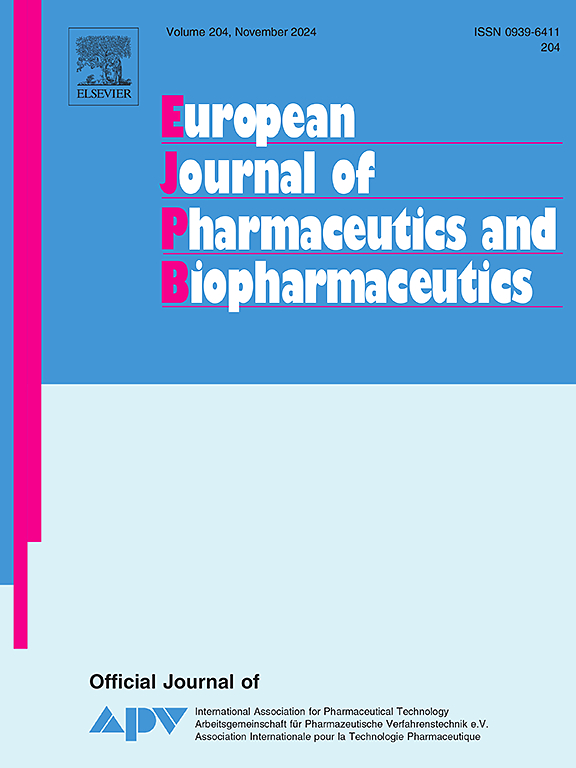Exploring yeast glucans for vaccine enhancement: Sustainable strategies for overcoming adjuvant challenges in a SARS-CoV-2 model
IF 4.4
2区 医学
Q1 PHARMACOLOGY & PHARMACY
European Journal of Pharmaceutics and Biopharmaceutics
Pub Date : 2024-10-24
DOI:10.1016/j.ejpb.2024.114538
引用次数: 0
Abstract
Vaccine adjuvants are important for enhancing vaccine efficacy, and although aluminium salts (Alum) are the most used, their limited ability to induce specific immune responses has spurred the search for new adjuvants. However, many adjuvants fail during product development due to manufacturability, supply, stability, or safety concerns. This work hypothesizes that protein-free yeast glucans can be used as vaccine adjuvants due to their known immunostimulatory activity and high abundancy. Thus, high molecular weight glucans with over 99% purity, comprising 64–70% β-glucans and 29–35% α-glucans, were extracted from a wild-type yeast and an engineered yeast to produce a steviol glycoside. These glucans underwent carboxymethylation to enhance solubility. Both water-dispersible and particulate glucans were evaluated as adjuvants, either alone or in combination with Alum or squalene stable emulsion (SE), for a SARS-CoV-2 vaccine. The study demonstrated that glucans triggered a robust immune response and enhanced the effects of Alum and SE when used in combination, both in vitro and in vivo. Water-dispersible glucans combined with Alum, and particulate glucans combined with SE, increased the production of specific antibodies against SARS-CoV-2 spike protein and enhanced serum neutralization titers against SARS-CoV-2 pseudovirus. Furthermore, the results indicated that larger molecular weight glucans from engineered yeast exhibited stronger immunogenic activity in comparison to wild-type yeast glucans. In conclusion, appropriately formulated glucans have the potential to be scalable, low-cost vaccine adjuvants, potentially overcoming the limitations of current adjuvants.

探索用于疫苗强化的酵母葡聚糖:在 SARS-CoV-2 模型中克服佐剂挑战的可持续战略。
疫苗佐剂对提高疫苗效力非常重要,虽然铝盐(明矾)是使用最多的佐剂,但其诱导特异性免疫反应的能力有限,这促使人们寻找新的佐剂。然而,许多佐剂在产品开发过程中由于可制造性、供应、稳定性或安全性等问题而失败。本研究假设,无蛋白酵母葡聚糖具有已知的免疫刺激活性和高丰度,可用作疫苗佐剂。因此,从野生型酵母和工程酵母中提取了纯度超过 99% 的高分子量葡聚糖,其中 64-70% 为 β-葡聚糖,29-35% 为 α-葡聚糖,以生产甜菊醇糖苷。这些葡聚糖经过了羧甲基化处理,以提高溶解度。研究人员评估了水分散葡聚糖和颗粒葡聚糖作为佐剂单独或与明矾或角鲨烯稳定乳液(SE)组合用于 SARS-CoV-2 疫苗的效果。研究表明,葡聚糖在体外和体内与明矾和角鲨烯稳定乳液结合使用时,可引发强大的免疫反应,并增强明矾和角鲨烯稳定乳液的效果。水分散性葡聚糖与明矾结合使用,以及颗粒状葡聚糖与 SE 结合使用,都能增加针对 SARS-CoV-2 尖峰蛋白的特异性抗体的产生,并提高针对 SARS-CoV-2 伪病毒的血清中和滴度。此外,研究结果表明,与野生型酵母葡聚糖相比,工程酵母中分子量较大的葡聚糖具有更强的免疫原性。总之,适当配制的葡聚糖有可能成为可扩展、低成本的疫苗佐剂,从而克服现有佐剂的局限性。
本文章由计算机程序翻译,如有差异,请以英文原文为准。
求助全文
约1分钟内获得全文
求助全文
来源期刊
CiteScore
8.80
自引率
4.10%
发文量
211
审稿时长
36 days
期刊介绍:
The European Journal of Pharmaceutics and Biopharmaceutics provides a medium for the publication of novel, innovative and hypothesis-driven research from the areas of Pharmaceutics and Biopharmaceutics.
Topics covered include for example:
Design and development of drug delivery systems for pharmaceuticals and biopharmaceuticals (small molecules, proteins, nucleic acids)
Aspects of manufacturing process design
Biomedical aspects of drug product design
Strategies and formulations for controlled drug transport across biological barriers
Physicochemical aspects of drug product development
Novel excipients for drug product design
Drug delivery and controlled release systems for systemic and local applications
Nanomaterials for therapeutic and diagnostic purposes
Advanced therapy medicinal products
Medical devices supporting a distinct pharmacological effect.

 求助内容:
求助内容: 应助结果提醒方式:
应助结果提醒方式:


